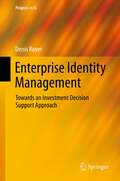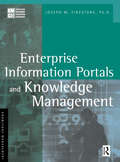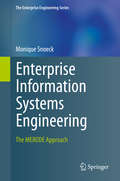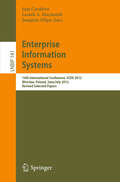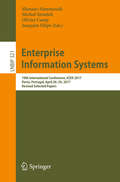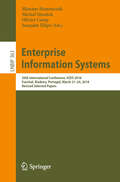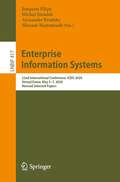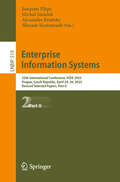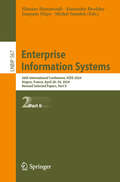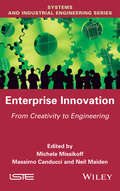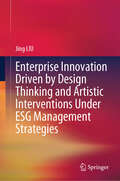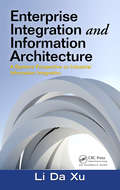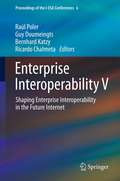- Table View
- List View
Enterprise IT at Cisco
by F. Warren Mcfarlan Andrew Mcafee Alison Berkley WagonfeldIllustrates the challenges associated with centralizing IT decisions at Cisco after a decade of decentralized planning and project funding. When Brad Boston became Cisco's new CIO in 2001, he found that managers were starting to get frustrated with the results of their latest IT initiatives. Boston believed that Cisco needed to focus on its global infrastructure before investing in more functional tools and applications. Under the leadership of Boston and an executive operating committee, Cisco selected three major enterprise projects that required an unprecedented level of process planning and cross-functional cooperation, a major change from Cisco's legacy of entrepreneurial drive. As these three projects started to wind down in 2004, Boston and the operating committee were thinking about what types of new projects the IT organization should support. Raises issues about change management, centralized planning, IT prioritization and resource allocation, enterprise cooperation, and project funding.
Enterprise Identity Management
by Denis RoyerThe introduction of Enterprise Identity Management Systems (EIdMS) in organizations even beyond the purely technological level is a costly and challenging endeavor. However, for decision makers it seems difficult to fully understand the impacts and opportunities arising from the introduction of EIdMS. This book explores the relevant aspects for an ex-ante evaluation of EIdMS. Therefore it examines this domain by employing a qualitative expert interview study to better understand the nature of EIdMS, as they are situated between security and productive IT systems. To this regard, the focus is put on the general nature of EIdMS projects and the constructs being relevant for analyzing such projects in the decision support phase. Based on the derived constructs and thematic topics from the interviews, an explanatory model for EIdMS introductions is derived and iteratively improved and evaluated. Finally, a possible application use-case for the creation of adequate decision support tools is presented.
Enterprise Information Management
by Paul BaanHow an organization manages its information is arguably the most important skill in today's dynamic and hyper-competitive environment. In Enterprise Information Management, editor Paul Baan and a team of expert contributors present a holistic approach to EIM, with an emphasis on action-oriented decision making. The authors demonstrate that EIM must be promoted from the top down, in order to ensure that the entire organization is committed to establishing and supporting the systems and processes designed to capture, store, analyze, and disseminate information. They identify three key "pillars" of applications: (1) business intelligence (the information and knowledge management process itself); (2) enterprise content management (company-wide management of unstructured information, including document management, digital asset management, records management, and web content management); and (3) enterprise search (using electronic tools to retrieve information from databases, file systems, and legacy systems). The authors explore EIM from economic and socio-psychological perspectives, considering the "ROI" (return on information) of IT and related technological investments, and the cultural and behavioral aspects through which people and machines interact. Illustrating concepts through case examples, the authors provide a variety of tools for managers to assess and improve the effectiveness of their EIM infrastructure, considering its implications for customer and client relations, process and system improvements, product and service innovations, and financial performance.
Enterprise Information Management in Practice
by Saumya ChakiLearn how to form and execute an enterprise information strategy: topics include data governance strategy, data architecture strategy, information security strategy, big data strategy, and strategy to move data warehouses to the cloud. Manage information like a pro, to achieve much better financial results for the enterprise, more efficient processes, and multiple advantages over competitors. As you''ll discover in Enterprise Information Management in Practice, EIM deals with both structured data (e. g. sales data and customer data) as well as unstructured data (like customer satisfaction forms, emails, documents, social network sentiments, and so forth). With the deluge of information that enterprises face given their global operations and complex business models, as well as the advent of big data technology, it is not surprising that making sense of the large piles of data is of paramount importance. Enterprises must therefore put much greater emphasis on managing and monetizing both structured and unstructured data. As Saumya Chaki--an information management expert and consultant with IBM--explains in Enterprise Information Management in Practice, it is now more important than ever before to have an enterprise information strategy that covers the entire life cycle of information and its consumption while providing security controls. With Fortune 100 consultant Saumya Chaki as your guide, Enterprise Information Management in Practice covers each of these and the other pillars of EIM in depth, which provide readers with a comprehensive view of the building blocks for EIM. Enterprises today deal with complex business environments where information demands take place in real time, are complex, and often serve as the differentiator among competitors. The effective management of information is thus crucial in managing enterprises. Enterprise Information Management (EIM) has evolved as a specialized discipline in the business intelligence and enterprise data warehousing space to address the complex needs of information processing and delivery--and to ensure the enterprise is making the most of its information assets. What you''ll learn The structure of your enterprise information management (EIM) program What kinds of data management strategies you need in place as part of the EIM program The key benefits of an EIM program The solution components in an EIM program The incremental roadmap to building an EIM organization and leverage the benefits Who this book is for All practitioners of information management including business information analysts, data scientists, IT professionals, IT managers, database administrators, senior information executives, and many others. While there are numerous books on data management and big data, there are very few books that tie up all the concepts in a holistic manner. Table of Contents Chapter 1: Enterprise Information Management : Definition, Scope, and History Chapter 2: Lifecycle of Enterprise Information Management Chapter 3: Components of Enterprise Information Management Chapter 4: Pillar #1: Information Sourcing Chapter 5: Pillar #2: Information Integration and Exchange Chapter 6: Pillar #3: Information Governance and Quality Chapter 7: Pillar #4: Master Information Management Chapter 8: Pillar #5: Information Warehousing Chapter 9: Pillar #6: Information Delivery and Consumption Chapter 10: Pillar #8: Metadata Management Chapter 11: Pillar #9: Big Data Components Chapter 12: Building an Enterprise Information Management Solution Chapter 13: EIM in Today''s Business Environment Appendix A - Glossary Appendix B - EIM Tools in the Marketplace
Enterprise Information Portals and Knowledge Management (Kmci Press Ser.)
by Joseph M. FirestoneIs the Enterprise Information Portal (EIP) knowledge management's killer app? Leading expert Joseph M. Firestone, the first author to formulate the idea of the Enterprise Knowledge Portal, breaks new ground and looks to the future with a practical, but comprehensive approach to enterprise portals and their relationship to knowledge management. Providing a clear and novel overview, Firestone tackles a wide range of topics ranging from functional EIP applications, estimating costs and benefits of EIPs, variations in EIP technical architecture, the role of intelligent agents, the nature of knowledge management, portal product/solution segmentation, portal product case studies, to the future of the EIP space. 'Enterprise Information Portals and Knowledge Management' is the book on portals you've been waiting for. It is the only book that thoroughly considers, explores, and analyzes:* The EIP orientation, outlook and evolution* A new methodology for estimating EIP benefits and costs* EIP and Enterprise Knowledge Portals (EKP) architecture* The approaching role of software agents in EIPs and EKPs* The current and future contribution of EIP and EKP solutions to Knowledge Management* The role of XML in portal architecture * A comprehensive, multi-dimensional, and forward-looking segmentation of EIP products accompanied by portal product case studies* Where EIP sector companies are headed and the pathways they will follow to get there
Enterprise Information Systems Engineering
by Monique SnoeckThe increasing penetration of IT in organizations calls for an integrative perspective on enterprises and their supporting information systems. MERODE offers an intuitive and practical approach to enterprise modelling and using these models as core for building enterprise information systems. From a business analyst perspective, benefits of the approach are its simplicity and the possibility to evaluate the consequences of modeling choices through fast prototyping, without requiring any technical experience. The focus on domain modelling ensures the development of a common language for talking about essential business concepts and of a shared understanding of business rules. On the construction side, experienced benefits of the approach are a clear separation between specification and implementation, more generic and future-proof systems, and an improved insight in the cost of changes. A first distinguishing feature is the method's grounding in process algebra provides clear criteria and practical support for model quality. Second, the use of the concept of business events provides a deep integration between structural and behavioral aspects. The clear and intuitive semantics easily extend to application integration (COTS software and Web Services). Students and practitioners are the book's main target audience, as both groups will benefit from its practical advice on how to create complete models which combine structural and behavioral views of a system-to-be and which can readily be transformed into code, and on how to evaluate the quality of those models. In addition, researchers in the area of conceptual or enterprise modelling will find a concise overview of the main findings related to the MERODE project. The work is complemented by a wealth of extra material on the author's web page at KU Leuven, including a free CASE tool with code generator, a collection of cases with solutions, and a set of domain modelling patterns that have been developed on the basis of the method's use in industry and government.
Enterprise Information Systems: 14th International Conference, ICEIS 2012, Wroclaw, Poland, June 28 - July 1, 2012, Revised Selected Papers (Lecture Notes in Business Information Processing #141)
by Leszek A. Maciaszek Joaquim Filipe José CordeiroThis book contains substantially extended and revised versions of the best papers from the 14th International Conference on Enterprise Information Systems (ICEIS 2012), held in Wroclaw, Poland, in June/July 2012.The 25 full and 3 invited papers included in this volume were carefully reviewed and selected from 299 submissions. They reflect state-of-the-art research work focusing mainly on real-world applications and highlighting the benefits of information systems and technology for industry and services, thus connecting academia with the world of real enterprises.The topics covered are: databases and information systems integration; artificial intelligence and decision support systems; information systems analysis and specification; software agents and internet computing; human-computer interaction; and enterprise architecture.Chapter “Time Efficiency of Point-of-Sale Payment Methods: Empirical Results for Cash, Cards and Mobile Payments” is available open access under a Creative Commons Attribution 4.0 International License via link.springer.com.
Enterprise Information Systems: 19th International Conference, ICEIS 2017, Porto, Portugal, April 26-29, 2017, Revised Selected Papers (Lecture Notes in Business Information Processing #321)
by Joaquim Filipe Slimane Hammoudi Olivier Camp Michał ŚmiałekThis book constitutes extended and revised papers from the 19th International Conference on Enterprise Information Systems, ICEIS 2017, held in Porto, Portugal, in April 2017. The 28 papers presented in this volume were carefully reviewed and selected for inclusion in this book from a total of 318 submissions. They were organized in topical sections named: databases and information systems integration; artificial intelligence and decision support systems; information systems analysis and specification; software agents and internet computing; human-computer interaction; and enterprise architecture.
Enterprise Information Systems: 20th International Conference, ICEIS 2018, Funchal, Madeira, Portugal, March 21-24, 2018, Revised Selected Papers (Lecture Notes in Business Information Processing #363)
by Joaquim Filipe Slimane Hammoudi Olivier Camp Michał ŚmiałekThis book constitutes extended, revised and selected papers from the 20th International Conference on Enterprise Information Systems, ICEIS 2018, held in Funchal, Madeira, Portugal, in March 2018. The 19 papers presented in this volume were carefully reviewed and selected for inclusion in this book from a total of 242 submissions. They deal with topics such as data science and databases; ontologies; social networks; knowledge management; software development; human-computer interaction, and multimedia.
Enterprise Information Systems: 21st International Conference, ICEIS 2019, Heraklion, Crete, Greece, May 3–5, 2019, Revised Selected Papers (Lecture Notes in Business Information Processing #378)
by Joaquim Filipe Slimane Hammoudi Michał Śmiałek Alexander BrodskyThis book constitutes extended, revised and selected papers from the 21st International Conference on Enterprise Information Systems, ICEIS 2019, held in Heraklion, Crete, Greece, in May 2019. The 26 papers presented in this volume were carefully reviewed and selected for inclusion in this book from a total of 205 submissions. They deal with topics such as data science and databases; ontologies; social networks; knowledge management; software development; human-computer interaction, and multimedia.
Enterprise Information Systems: 22nd International Conference, ICEIS 2020, Virtual Event, May 5–7, 2020, Revised Selected Papers (Lecture Notes in Business Information Processing #417)
by Joaquim Filipe Slimane Hammoudi Michał Śmiałek Alexander BrodskyThis book constitutes extended, revised and selected papers from the 22nd International Conference on Enterprise Information Systems, ICEIS 2020, held online during May 5-7, 2020.The 41 papers presented in this volume were carefully reviewed and selected for inclusion in this book from a total of 255 submissions. They were organized in topical sections as follows: database and information systems integration; artificial intelligence and decision support systems; information systems analysis and specification; software agents and internet computing; human-computer interaction; and enterprise architecture.
Enterprise Information Systems: 23rd International Conference, ICEIS 2021, Virtual Event, April 26–28, 2021, Revised Selected Papers (Lecture Notes in Business Information Processing #455)
by Joaquim Filipe Slimane Hammoudi Michał Śmiałek Alexander BrodskyThis book contains extended, revised and selected papers from the 23rd International Conference on Enterprise Information Systems, ICEIS 2021, held online during April 2021. The 26 papers presented in this volume were carefully reviewed and selected for inclusion from a total of 241 submissions. They are grouped in sections on databases and information systems integration, artificial intelligence and decision support systems, information systems analysis and specification, software agents and internet computing, human-computer interaction, and enterprise architecture.
Enterprise Information Systems: 24th International Conference, ICEIS 2022, Virtual Event, April 25–27, 2022, Revised Selected Papers (Lecture Notes in Business Information Processing #487)
by Joaquim Filipe Slimane Hammoudi Michał Śmiałek Alexander BrodskyThis book constitutes the refereed post-conference proceedings of the 24th International Conference on Enterprise Information Systems, ICEIS 2022, This conference was held virtually due to the COVID-19 crisis, during April 25-27, 2022.The 20 full papers included in this book were carefully reviewed and selected from 197 submissions. They were organized in topical sections as follows: Databases and Information Systems Integration; Artificial Intelligence and Decision Support Systems; Information Systems Analysis and Specification; Human-Computer Interaction; and Enterprise Architecture.
Enterprise Information Systems: 25th International Conference, ICEIS 2023, Prague, Czech Republic, April 24–26, 2023, Revised Selected Papers, Part I (Lecture Notes in Business Information Processing #518)
by Joaquim Filipe Slimane Hammoudi Michał Śmiałek Alexander BrodskyThis two-volume set constitutes the refereed post-conference proceedings of the 25th International Conference on Enterprise Information Systems, ICEIS 2023, which was held in Prague, Czech Republic, during April 2023. The 41 full papers and 66 short papers presented were carefully reviewed and selected from 213 submissions. They are organized in topical sections as follows: Part One : Databases and Information Systems Integration; Artificial Intelligence and Decision Support Systems; and Information Systems Analysis and Specification. Part Two : Software Agents and Internet Computing; Human-Computer Interaction; and Enterprise Architecture.
Enterprise Information Systems: 25th International Conference, ICEIS 2023, Prague, Czech Republic, April 24–26, 2023, Revised Selected Papers, Part II (Lecture Notes in Business Information Processing #519)
by Joaquim Filipe Slimane Hammoudi Michał Śmiałek Alexander BrodskyThe two-volume set LNBIP 518 and 519 constitutes the refereed post-conference proceedings of the 25th International Conference on Enterprise Information Systems, ICEIS 2023, which was held in Prague, Czech Republic, during April 2023. The 30 full papers included in these proceedings were carefully reviewed and selected from a total of 213 submissions. They are organized in topical sections as follows: Part One : Databases and Information Systems Integration; Artificial Intelligence and Decision Support Systems; and Information Systems Analysis and Specification. Part Two : Software Agents and Internet Computing; Human-Computer Interaction; and Enterprise Architecture.
Enterprise Information Systems: 26th International Conference, ICEIS 2024, Angers, France, April 28–30, 2024, Revised Selected Papers, Part I (Lecture Notes in Business Information Processing #566)
by Joaquim Filipe Slimane Hammoudi Michał Śmiałek Alexander BrodskyThe two volume set LNBIP 566 - 567 constitutes the refereed post-conference proceedings of the 26th International Conference on Enterprise Information Systems, ICEIS 2024, which was held in Angers, France, during April 2024. The 19 full papers and 18 short papers presented were carefully reviewed and selected from 244 submissions. The proceedings also include one invited paper in full paper length. The purpose of the International Conference on Enterprise Information Systems (ICEIS) is to bring together researchers, engineers and practitioners interested in the advances and business applications of information systems, covering different aspects such as Enterprise Database Technology, Systems Integration, Artificial Intelligence, Decision Support Systems, Information Systems Analysis and Specification, Internet Computing, Electronic Commerce, Human-Computer Interaction and Enterprise Architecture.
Enterprise Information Systems: 26th International Conference, ICEIS 2024, Angers, France, April 28–30, 2024, Revised Selected Papers, Part II (Lecture Notes in Business Information Processing #567)
by Joaquim Filipe Slimane Hammoudi Michał Śmiałek Alexander BrodskyThe two volume set LNBIP 566 - 567 constitutes the refereed post-conference proceedings of the 26th International Conference on Enterprise Information Systems, ICEIS 2024, which was held in Angers, France, during April 2024. The 19 full papers and 18 short papers presented were carefully reviewed and selected from 244 submissions. The proceedings also include one invited paper in full paper length. The purpose of the International Conference on Enterprise Information Systems (ICEIS) is to bring together researchers, engineers and practitioners interested in the advances and business applications of information systems, covering different aspects such as Enterprise Database Technology, Systems Integration, Artificial Intelligence, Decision Support Systems, Information Systems Analysis and Specification, Internet Computing, Electronic Commerce, Human-Computer Interaction and Enterprise Architecture.
Enterprise Innovation
by Neil Maiden Massimo Canducci Michele MissikoffThe World is changing and then also how enterprises carry out innovation needs to change. The book presents new methods and tools (from Creativity to Engineering), aimed at promoting and sustaining enterprise innovation and production improvement. The book is primarily (but not exclusively) based on the new approaches, methods, frameworks, and tools conceived for enterprise innovation and production improvement, developed during the European Project BIVEE (Business Innovation for Virtual Enterprise Ecosystems. ) Addressed topics range from Open Innovation in Virtual Enterprises to shared virtual spaces for collaborative creativity, to Innovation metrics and monitoring in the context of networked SMEs.
Enterprise Innovation Driven by Design Thinking and Artistic Interventions Under ESG Management Strategies
by Jing LIUThis study examines the management strategies of representative companies in each country to gain insight into the value of ESG management strategies for corporate innovation and how design thinking and artistic interventions can foster creativity both internally and externally to drive corporate innovation. It compares the current state of design and/or art-driven innovation strategies in Korean and Chinese companies under ESG frameworks, and then discusses the challenges of corporate innovation in these countries. Based on the results of the comparison, the study suggests the future of corporate innovation in China.
Enterprise Innovation Ecosystem: Theory and Practice
by Jin ChenThis book targets the key issues of both research and practice in innovation and strategic management fields and is regarded as one of the important works explaining enterprises from the innovation system perspective. The book is based on the existing literature involving national innovation system, regional innovation system, and industrial/sectional innovation system and reviews intra-organizational innovation system researches and inter-organizational innovation ecosystem literature. Accordingly, the book proposes a “core competence-based innovation ecosystem framework”, indicating the importance of fit between firms' internal core competence and external innovation ecosystem, which is pivotal for leveraging the sustainable competitiveness advantages. In addition, the book further adopts multiple case studies, involving the firms' innovation ecosystems upon ten typical global enterprises in and out of China – e.g., Apple Inc., Siemens, Procter & Gamble, Microsoft Corporation, Google, Founder Group, Haier Group, China South Railway, Huawei, and Midea. Teachers and researchers from universities in innovation and strategic management fields and industrial management practitioners can benefit from the book.
Enterprise Integration and Information Architecture: A Systems Perspective on Industrial Information Integration (Advances In Systems Science And Engineering (asse) Ser.)
by Li Da XuEnterprise solutions have emerged as promising tools for integrating and extending business processes across business functions. Supplying a clear and comprehensive introduction to the field, this book provides a detailed description of enterprise information integration-from the development of enterprise systems to extended enterprise information
Enterprise Integration with Azure Logic Apps: Integrate legacy systems with innovative solutions
by Matthew Bennett Tim ChildeLearn how to create sophisticated and reliable Logic Apps with improved UXKey FeaturesBecome an Azure Master and create data flows within a matter of minutesPerform transfers using Logic Apps with prompt resultsCreate powerful Logic Apps by enhancing your systems to improve user experienceBook DescriptionLogic Apps are a visual flowchart-like representation of common programming actions, and are a flexible way to create logic without writing a single line of code. Enterprise Integration with Azure Logic Apps is a comprehensive introduction for anyone new to Logic Apps which will boost your learning skills and allow you to create rich, complex, structured, and reusable logic with instant results.You'll begin by discovering how to navigate the Azure portal and understand how your objects can be zoned to a specific environment by using resource groups. Complete with hands-on tutorials, projects, and self-assessment questions, this easy-to-follow guide will teach you the benefits and foundations of Logic App logic design. As you advance, you'll find out how to manage your Azure environment in relation to Logic Apps and how to create elegant and reliable Logic Apps. With useful and practical explanations of how to get the most out of Logic App actions and triggers, you'll be able to ensure that your Logic Apps work efficiently and provide seamless integration for real-world scenarios without having to write code.By the end of this Logic Apps book, you'll be able to create complex and powerful Logic Apps within minutes, integrating large amounts of data on demand, enhancing your systems, and linking applications to improve user experience.What you will learnUnderstand how to use blades, overview pages, and subscription pagesDiscover how to create a Microsoft account to manage your tenantUse a Visual Studio subscription with Azure to manage your Logic AppsFind out how to manage the cloud by analyzing runs, executions, and costsCreate resource groups to zone your enterprise environmentsSupport a development life cycle from sandbox through to productionWho this book is forIf you are an aspiring infrastructure technician who already uses Azure in place of on-premises solutions and is now looking to link systems together, then this book is for you. This book is also for developers interested in systems integration where legacy systems may not have a direct data link and the cloud is the intermediary step. Power users with existing IT skills and experience with Power BI and Power Automate will also find this book useful.
Enterprise Interoperability IX: Interoperability in the Era of Artificial Intelligence (Proceedings of the I-ESA Conferences #10)
by Bob Young Bernard Archimède Yves Ducq Hedi KarrayThis book gathers the proceedings of the I-ESA’20 Conference, which was organised by the National Engineering School of Tarbes (ENIT), on behalf of the European Virtual Laboratory, for Enterprise Interoperability (INTEROP-VLab) and the Pole Grand Sud-Ouest (PGSO) and was held virtually in Tarbes, France, in November 2020. It presents contributions ranging from academic research and case studies to industrial and administrative experiences with interoperability. These contributions show how, in a globalised market scenario—where the ability to cooperate with other organisations efficiently is essential in order to remain economically, socially and environmentally cost-effective—the most innovative digitised and networked enterprises ensure that their systems and applications can interoperate across heterogeneous collaborative networks of independent organisations. The focus of this edition of the conference is on interoperability in the era of artificial intelligence and so particular attention is paid to Industry 4.0 and the Internet of Things. The content also addresses smart services and the business impact of enterprise interoperability on organisations. Many of the papers in this tenth volume of the I-ESA Conference proceedings include examples and illustrations to help deepen readers’ understanding and generate new ideas. Offering a detailed guide to the state of the art in systems interoperability, the book will be of great value to all engineers and computer scientists working in manufacturing and other process industries, and to software engineers and electronic and manufacturing engineers working in academic settings.
Enterprise Interoperability V
by Bernhard Katzy Raúl Poler Guy Doumeingts Ricardo ChalmetaWithin a scenario of globalised markets, where the capacity to efficiently cooperate with other firms starts to become essential in order to remain in the market in an economically, socially and environmentally cost-effective manner, it can be seen how the most innovative enterprises are beginning to redesign their business model to become interoperable. This goal of interoperability is essential, not only from the perspective of the individual enterprise but also in the new business structures that are now emerging, such as supply chains, virtual enterprises, interconnected organisations or extended enterprises, as well as in mergers and acquisitions. Composed of over 40 papers, Enterprise Interoperability V ranges from academic research through case studies to industrial and administrative experience of interoperability. The international nature of the authorship contnues to broaden. Many of the papers have examples and illustrations calculated to deepen understanding and generate new ideas. The I-ESA'12 Conference from which this book is drawn was organized by Polytechnic University of Valencia, on behalf INTERVAL, and the European Virtual Laboratory for Enterprise Interoperability (INTEROP-VLab) and sponsored by the International Federation for Information Processing (IFIP) and the International Federation of Automatic Control (IFAC). A concise reference to the state of the art in systems interoperability, Enterprise Interoperability V will be of great value to engineers and computer scientists working in manufacturing and other process industries and to software engineers and electronic and manufacturing engineers working in the academic environment.
Enterprise Interoperability X: Enterprise Interoperability Through Connected Digital Twins (Proceedings of the I-ESA Conferences #11)
by David Romero Yves Ducq Raúl Rodríguez-Rodríguez Ramona-Diana LeonEnterprise Interoperability X presents contributions ranging from academic research and case studies, to industrial and administrative experiences with interoperability. These contributions help organizations to analyse and improve their products and processes in the face of the high degree of uncertainty in the current commercial environment, and to predict their performance. To this end, the contributors exploit digital twin technology that integrates tools from the Internet of Things, artificial intelligence and software analytics. Enterprise interoperability necessarily arises from the processes required to make associated digital twins work together. The book forms the proceedings of the I-ESA’22 Conference, which was organised by the Universidad Politécnica de Valencia, on behalf of INTERVAL and the European Virtual Laboratory for Enterprise Interoperability (INTEROP-VLab), and was held in Valencia, Spain in March 2022. Many of the papers in this eleventh volume ofthe Proceedings of the I-ESA Conferences include examples and illustrations to help deepen readers’ understanding and generate new ideas. Offering a detailed guide to the state of the art in systems interoperability, the book will be of great value to all engineers and computer scientists working in manufacturing and other process industries, and to software engineers and electronic and manufacturing engineers working in academic settings.

